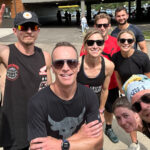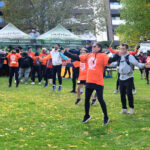Six weeks out from a race is a crucial period for training, race-specific preparation, goal setting and logistic planning.
There’s a lot to consider. So Battlefords-based run coach Hailey Thompson took some time to speak to the Brainsport Times to identify key things to consider in the month and a half leading up to race day.
Make sure your training plan is realistic
Whether you’re working with a coach or following an online training plan, look ahead and make sure the plan is sustainable based on your health and training availability. If it’s not realistic, consider dropping down your race distance or planning for a race at a different date. If you are struggling with motivation, find a training partner to help with accountability.
If you’re dealing with an injury, don’t push through pain just to make it to the race. You can always find another race to run when you are healed up. Think of running for the long-term versus a short-term goal.
Hone in on your nutrition
No one wants to experience stomach issues on race day, so make sure to be working on a nutrition plan now to minimize that possibility.
Practice pre-run meals to know what does and doesn’t work for you. Pre-race meals should consist of about 50-75g of carbohydrates and be easily digestible (eg. oatmeal, bagels/toast with peanut butter and a banana, smoothies, energy/granola bars).
For longer distances where you will be taking in fuel during the race, practice fuelling during long, hard workouts so you know what works for you. If at all possible, practice with what the race will be offering on the course — this information is often on race websites.
For races lasting longer than 90 minutes, aim to consume 0.32-0.45g of carbs per lb of bodyweight per hour.
Also for those longer races, plan to carb load in the days leading up to the race.

Don’t forget to do strength work
Incorporate strength training, stretching and mobility work into your plan even if it is one or two days a week for 20-30 minutes. You don’t need fancy equipment to have an effective workout. Head to instagram.com/runwithhails to see some videos of great strength workouts for runners.
Don’t forget to do speed work
Incorporate some speed work into your plan if you have a time goal in mind. Speed workouts typically involve intervals done at your 5km pace or quicker and are important because you need to practice running fast to get fast. These workouts can also help you work on high cadence and can let you practice being physically and mentally uncomfortable — something that is bound to happen in a race.
Try out your race kit
Wear your race day gear and shoes in training runs to be sure they are the proper fit and won’t cause discomfort or chafing during the race.
Set goals
If you have time, complete a tune-up race or time trial leading up to your key event to see where your fitness is at. This is often done at a distance less than your marquee race (i.e. a half marathon can be a tune-up race for a marathon).
Completing a tune-up race or time trial can help you set A, B and C goals for the race. Your A-goal is a perfect scenario; your B goal is something within reach, but challenging and your C goal is something that can leave you proud of your efforts regardless of what race day throws at you. For many runners, finishing the race is their C goal.
For more on the importance of setting race goals, head to the Brainsport blog.
Look into race logistics
Make sure to check when and where package pick-up is, since the majority of races don’t have same-day pick-up.
Know how to get to and from the race and make sure to allow additional time for parking when planning when to leave.
Look into the weather and plan accordingly
Check the weather in the days leading up to the race to get an idea of what it will be like. You may start out cold, but your body will warm up within a couple of miles so don’t overdress. If you’re concerned about being cold at the start take some “throw away” clothes that you can discard after the gun goes off or in the first few kilometres when you warm up.
Particularly if you’re travelling for a race, be prepared with a couple of different race day outfits so you can adapt to the weather and remember to practice running in all of them.
Don’t forget to taper
Run your longest run three to four weeks out from race day. Depending on your experience and the distance you’re running, the taper begins one to three weeks out from the race and should involve reducing training volume so you’re as fresh as possible on race day.
Cut back on strength training and high intensity workouts during this period and remember to drink lots of water.
The day before the race stay off your feet and rest.
Plan for post-race
Recovery starts immediately after you cross the finish line. Have warm clothes to change into post race and try to eat something within 15-30 minutes of finishing.
Most importantly, go out and have fun and reward yourself with your favourite food or beverage at the end! It’s deserved.
Hailey Thompson is a marathon runner and certified running coach. You can follow her on Instagram @runwithhails for great running and training tips and check out her website runwithhails.com for more information.
This article was originally published on April 12, 2022. It was updated in July 2025.









